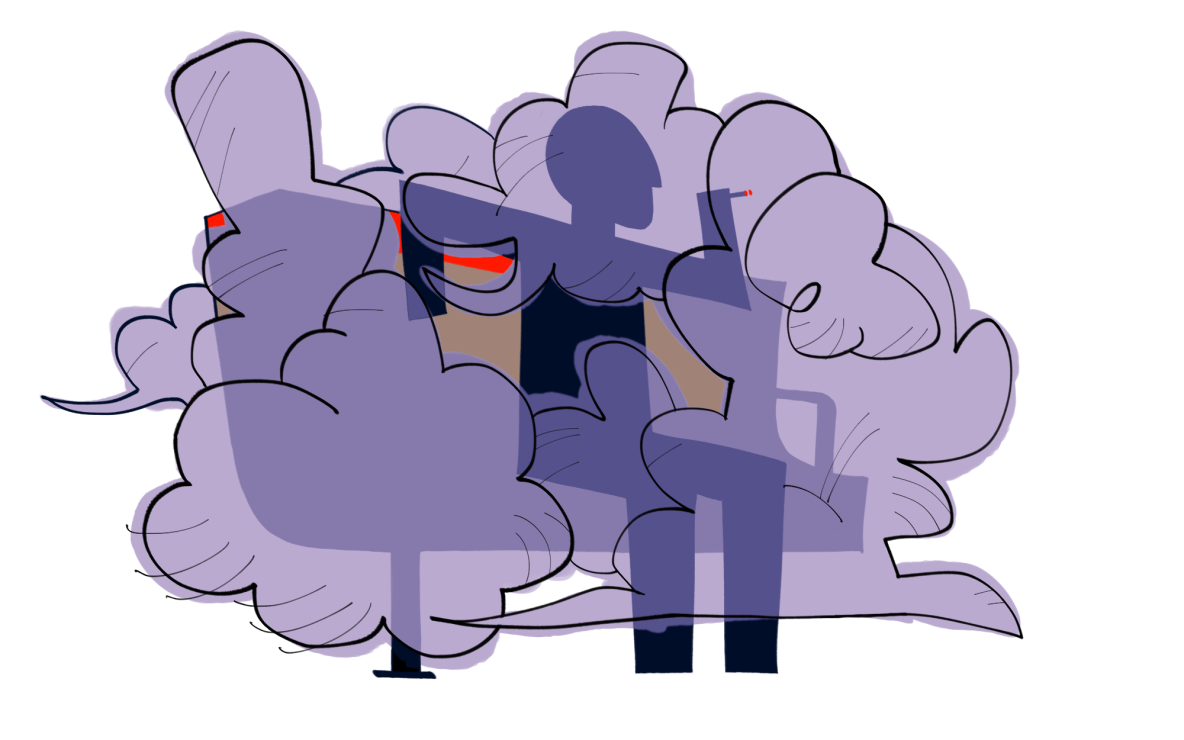A harm reductionist perspective says the solution isn’t so simple

Graphic by Parris Mook-Sang-Forbes.
Following the legalization of cannabis in 2018, there was a surge in Canadian universities instating 100 per cent smoke-free campus policies, but since then, momentum to go smoke-free has slowed — and the BC Cancer Society is concerned.
UVic’s campus smoking model includes 16 designated smoking areas, which are stationed around campus accessibly distanced from each building, but not within the main ring. Designated smoke areas are strategically placed in the least densely-populated areas on campus, to reduce the risk of second-hand smoke, according to a UVic spokesperson.
The policy was instituted in 2011, and updated in 2018 to include regulations for cannabis smoking.
As of August 2022, about 38 per cent (100 of 260) of colleges and universities in Canada are entirely smoke-free, though the Canadian Cancer Society (CCS) notes that more may have been added to the list since then. According to Rob Cunningham, a senior policy analyst with the CCS, so long as some campuses remain tolerant of smoking, their fight will continue.
“It’s the right thing to do,” Cunningham says of instituting smoke-free policies.
He explained in an interview with the Martlet that smoke-free university campus regulations help to discourage smoking, especially in underage youth, reduce litter and clean-up costs, lessen second-hand smoke exposure, and demonstrate health leadership.
“[Universities] should be providing [an] example, as the institutions of higher learning, given what we know about the horrific health effects of smoking,” said Cunningham. “As a society, we need to do everything we can to discourage smoking.”
The CCS is a statistical expert when it comes to Canadian universities’ smoking policies, as evidenced by their 2022 report. Smoke-free campus solutions, according to an emailed statement, are “a measure that [they] strongly support,” as regulations that dissuade and prevent smoking align with their preventative mission against cancer.
It is worth noting, though, that the plea from the CCS comes strictly from a health data standpoint.
According to Taha Qureshi, who worked as a live-in community leader (CL) at UVic residences for two years, it’s also important to consider the social and risk-minimizing components of a partially smoke-tolerant policy, like UVic’s.
Qureshi’s standpoint reflects the idea that the social benefits of a smoke bench, a shared space where a sense of community is fostered, are invaluable and deserve a place in the conversation about smoking policies on university campuses.
“I smoked a ton on campus,” Qureshi said. “I’m very passionate about the smoke benches.”
Qureshi explained that he met most of the people he knew in his first year at the smoke benches. He says that even non-regular smokers come to the smoke benches to have a conversation, meet new people, and find a sense of social belonging.
Aside from the loss of community, Qureshi also worries removing campus smoke benches will jeopardize the safety of students who smoke.
Rather than an outright ban, some proponents advocate for a harm reduction approach, which, according to the National Harm Reduction Coalition, is a set of strategies that aim to reduce negative consequences of substance use, while respecting the rights of people who use substances.
Access to safer use minimizes risk, as a UVic spokesperson touches on in their statement about the university’s stance on campus cannabis use.
“We recognize that students, staff and faculty have the right to make their own choices about their health and, as such, we’ve ensured that spaces are available for those who wish to smoke,” reads the email. “UVic does not promote cannabis use, but we know that some people will choose to use it. Our approach includes prevention, harm reduction and health promotion.”
To UVic’s policy, Cunningham said that, “a large proportion of smokers, especially young smokers, underestimate the severity of the health effects.” He further emphasized that if other universities can successfully implement a smoke-free policy as a preventative measure, it is feasible for UVic to do the same.
“There was a time when you could smoke on highschool grounds. That’s no longer the case,” said Cunningham. “Times have really changed for smoking.”
While indeed times have changed for smoking, ideas about harm reduction have also swum further into the mainstream in recent years. Now, we are left to wait and wonder whether UVic’s harm reductionist model will hold up against the public health advice of the coming years.








